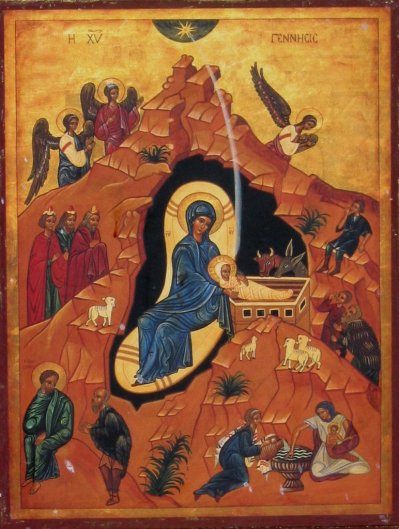NATIVITY
Immensity cloistered in thy dear womb,
Now leaves His well-belov’d imprisonment,
There He hath made Himself to His intent
Weak enough, now into the world to come;
But O, for thee, for Him, hath the inn no room?
Yet lay Him in this stall, and from the Orient,
Stars and wise men will travel to prevent
The effect of Herod’s jealous general doom.
Seest thou, my soul, with thy faith’s eyes, how He
Which fills all place, yet none holds Him, doth lie?
Was not His pity towards thee wondrous high,
That would have need to be pitied by thee?
Kiss Him, and with Him into Egypt go,
With His kind mother, who partakes thy woe.
-John Donne

A blessed Christmas to you, and every good wish for the coming year. John Donne isn’t a poet for our age, I fear — to complex, too filled with words more complicated than “awesome — but he always rewards a slower, more intentional reading.
And, as always, the icon rewards attention, too.
LikeLiked by 1 person
Love this. Merry Christmas, Gretchen! 🙂
LikeLiked by 1 person
Very thoughtful post, Gretchen; just right for approaching our celebration. Thank you!
I hadn’t thought about the similarities between a sonnet and an icon. But your pairing of them brings out the precision of compressed detail and the formality of style in both approaches to the same event. It takes attention and an inner silence to experience the power of each work. If icons are said to be “written,” surely a poem like this must have been “built” reverently word by word, phrase by phrase. A good example of that for me is the line,
“But O, for thee, for Him, hath the inn no room?”
I was struck by how making a question out of a simple statement from the King James translation (“…because there was no room for them at the inn”) demands that we reflect seriously on the world’s inhospitality to strangers, and ours to God. The rhythm of the line does this too.
Three brief pauses in the first six words, each one a single sound, and then the longer pause–as if for a breath–between “Him” and “hath,” followed by three single-word stresses at the end (the way I read it, six out of the eleven syllables in the line are stressed, and four of the six are said with even greater emphasis): all this adds emotion and drama to the meaning.
And that’s just one line! The rest are equally well crafted, as are the details of that icon (which I haven’t even started to attend to; I’m saving that for later tonight).
In return, I’ll share similar pairing that I came across today. It is lighter in tone and far more brief in expression, but the combination of image and words shows how nature, at least, welcomes everyone, and by poetic extension, welcomes Him.
https://leafandtwig.wordpress.com/2016/12/23/snowed-inn/
LikeLiked by 1 person
Love John Donne. Love you! Thank you for another year of erudition and gentle wisdom x
LikeLiked by 1 person